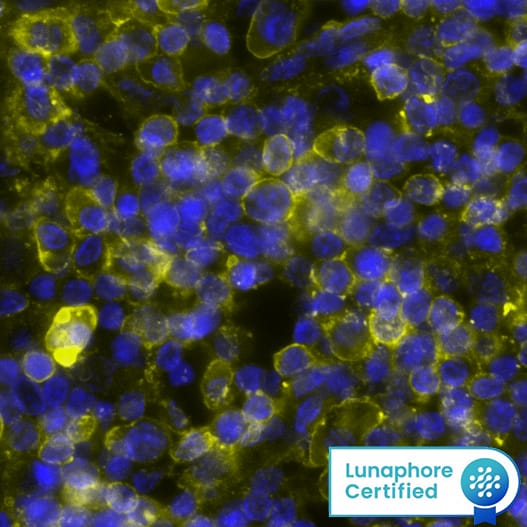Human S1P1/EDG-1 Antibody
Human S1P1/EDG-1 Antibody Summary
Met1-Ser382
Accession # P21453
Customers also Viewed
Applications
Please Note: Optimal dilutions should be determined by each laboratory for each application. General Protocols are available in the Technical Information section on our website.
Scientific Data
 View Larger
View Larger
Detection of S1P1/EDG‑1 in CHO Chinese Hamster Cell Line Transfected with Human S1P1/EDG-1 and eGFP by Flow Cytometry. CHO Chinese hamster ovary cell line transfected with either (A) human S1P1/EDG-1 or (B) irrelevant transfectants and eGFP were stained with Mouse Anti-Human S1P1/EDG-1 Monoclonal Antibody (Catalog # MAB2016) followed by Phycoerythrin-conjugated Anti-Mouse IgG Secondary Antibody (Catalog # F0102B). Quadrant markers were set based on control antibody staining (Catalog # MAB0041). View our protocol for Staining Membrane-associated Proteins.
 View Larger
View Larger
Detection of Human S1P1/EDG-1 by Flow Cytometry S1PR1 expression by OECs is dynamically altered by microenvironment.OEC expression of S1PR1 under normoxia and hypoxia was qualitatively confirmed by immunocytochemistry (A). The percentage of cells expressing S1PR1 on the cell surface, as confirmed with flow cytometry, was enhanced under hypoxia as compared to the normoxic control (B). Combined stimuli of S1P and VEGF resulted in greater S1PR1 mRNA production after 24h in normoxia (C). Combined stimuli also resulted in a greater proportion of S1PR1+ OECs under both normoxia and hypoxia (D and E). Scale bars represent 40 μm. Data are mean ± SD (n = 4) and normalized to the average untreated control values for either normoxia or hypoxia (C, E; indicated by dashed line) accordingly. An asterisk indicates statistically significant differences (P<0.05) between conditions in normoxia or hypoxia respectively and N.S. displays no statistically significant difference between conditions. Image collected and cropped by CiteAb from the following publication (https://dx.plos.org/10.1371/journal.pone.0123437), licensed under a CC-BY license. Not internally tested by R&D Systems.
Preparation and Storage
- 12 months from date of receipt, -20 to -70 °C as supplied.
- 1 month, 2 to 8 °C under sterile conditions after reconstitution.
- 6 months, -20 to -70 °C under sterile conditions after reconstitution.
Background: S1P1/EDG-1
S1P1, also known as EDG-1, is a member of the endothelial differentiation gene family. It is a high affinity G protein-coupled receptor for the bioactive lipid, Sphingosine-1-phosphate. S1P1 signaling regulates endothelial cell survival, cytoskeletal remodeling, chemotaxis, and angiogenesis.
Product Datasheets
Citations for Human S1P1/EDG-1 Antibody
R&D Systems personnel manually curate a database that contains references using R&D Systems products. The data collected includes not only links to publications in PubMed, but also provides information about sample types, species, and experimental conditions.
11
Citations: Showing 1 - 10
Filter your results:
Filter by:
-
Development and application of a high-content virion display human GPCR array
Authors: Guan-Da Syu, Shih-Chin Wang, Guangzhong Ma, Shuang Liu, Donna Pearce, Atish Prakash et al.
Nature Communications
-
Arsenic Trioxide and (-)-Gossypol Synergistically Target Glioma Stem-Like Cells via Inhibition of Hedgehog and Notch Signaling
Authors: Linder B, Wehle A, Hehlgans S et al.
Cancers (Basel)
-
Sphingosine-1-phosphate receptor 1/5 selective agonist alleviates ocular vascular pathologies
Authors: Nakamura, S;Yamamoto, R;Matsuda, T;Yasuda, H;Nishinaka, A;Takahashi, K;Inoue, Y;Kuromitsu, S;Shimazawa, M;Goto, M;Narumiya, S;Hara, H;
Scientific reports
Species: Human
Sample Types: Whole Cells
Applications: Flow Cytometry -
The GPCR adaptor protein Norbin regulates S1PR1 trafficking and the morphology, cell cycle and survival of PC12 cells
Authors: Johansen, VBI;Hampson, E;Tsonou, E;Pantarelli, C;Chu, JY;Crossland, L;Okkenhaug, H;Massey, AJ;Hornigold, DC;Welch, HCE;Chetwynd, SA;
Scientific reports
Species: Rat
Sample Types: Whole Cells
Applications: Flow Cytometry -
An S1P1 agonist, ASP4058, suppresses intracranial aneurysm through promoting endothelial integrity and blocking macrophage transmigration
Authors: R Yamamoto, T Aoki, H Koseki, M Fukuda, J Hirose, K Tsuji, K Takizawa, S Nakamura, H Miyata, N Hamakawa, H Kasuya, K Nozaki, Y Hirayama, I Aramori, S Narumiya
Br. J. Pharmacol., 2017-05-27;0(0):.
Species: Human
Sample Types: Whole Cells
Applications: Flow Cytometry -
Hypoxia augments outgrowth endothelial cell (OEC) sprouting and directed migration in response to sphingosine-1-phosphate (S1P).
Authors: Williams P, Stilhano R, To V, Tran L, Wong K, Silva E
PLoS ONE, 2015-04-15;10(4):e0123437.
Species: Human
Sample Types: Whole Cells
Applications: Flow Cytometry -
Expression of functional sphingosine-1 phosphate receptor-1 is reduced by B cell receptor signaling and increased by inhibition of PI3 kinase delta but not SYK or BTK in chronic lymphocytic leukemia cells.
Authors: Till K, Pettitt A, Slupsky J
J Immunol, 2015-01-28;194(5):2439-46.
Species: Human
Sample Types: Whole Cells
Applications: Flow Cytometry -
Sphingosine-1-phosphate (S1P) displays sustained S1P1 receptor agonism and signaling through S1P lyase-dependent receptor recycling.
Authors: Gatfield J, Monnier L, Studer R, Bolli M, Steiner B, Nayler O
Cell Signal, 2014-04-02;26(7):1576-88.
Species: Human
Sample Types: Whole Cells
Applications: Flow Cytometry -
New B-cell CD molecules.
Authors: Matesanz-Isabel J, Sintes J, Llinas L, de Salort J, Lazaro A, Engel P
Immunol. Lett., 2010-10-07;134(2):104-12.
Species: Human
Sample Types: Whole Cells
Applications: Flow Cytometry -
Analysis of HLDA9 mAbs on plasmacytoid dendritic cells.
Authors: Cabezon R, Sintes J, Llinas L, Benitez-Ribas D
Immunol. Lett., 2010-10-07;134(2):167-73.
Species: Human
Sample Types: Whole Cells
Applications: Flow Cytometry -
Soluble forms of VEGF receptor-1 and -2 promote vascular maturation via mural cell recruitment.
Authors: Lorquet S, Berndt S, Blacher S, Gengoux E, Peulen O, Maquoi E, Noel A, Foidart JM, Munaut C, Pequeux C
FASEB J., 2010-05-19;24(10):3782-95.
Species: Human
Sample Types: Cell Lysates
Applications: Western Blot
FAQs
No product specific FAQs exist for this product, however you may
View all Antibody FAQsIsotype Controls
Reconstitution Buffers
Secondary Antibodies
Reviews for Human S1P1/EDG-1 Antibody
There are currently no reviews for this product. Be the first to review Human S1P1/EDG-1 Antibody and earn rewards!
Have you used Human S1P1/EDG-1 Antibody?
Submit a review and receive an Amazon gift card.
$25/€18/£15/$25CAN/¥75 Yuan/¥2500 Yen for a review with an image
$10/€7/£6/$10 CAD/¥70 Yuan/¥1110 Yen for a review without an image














